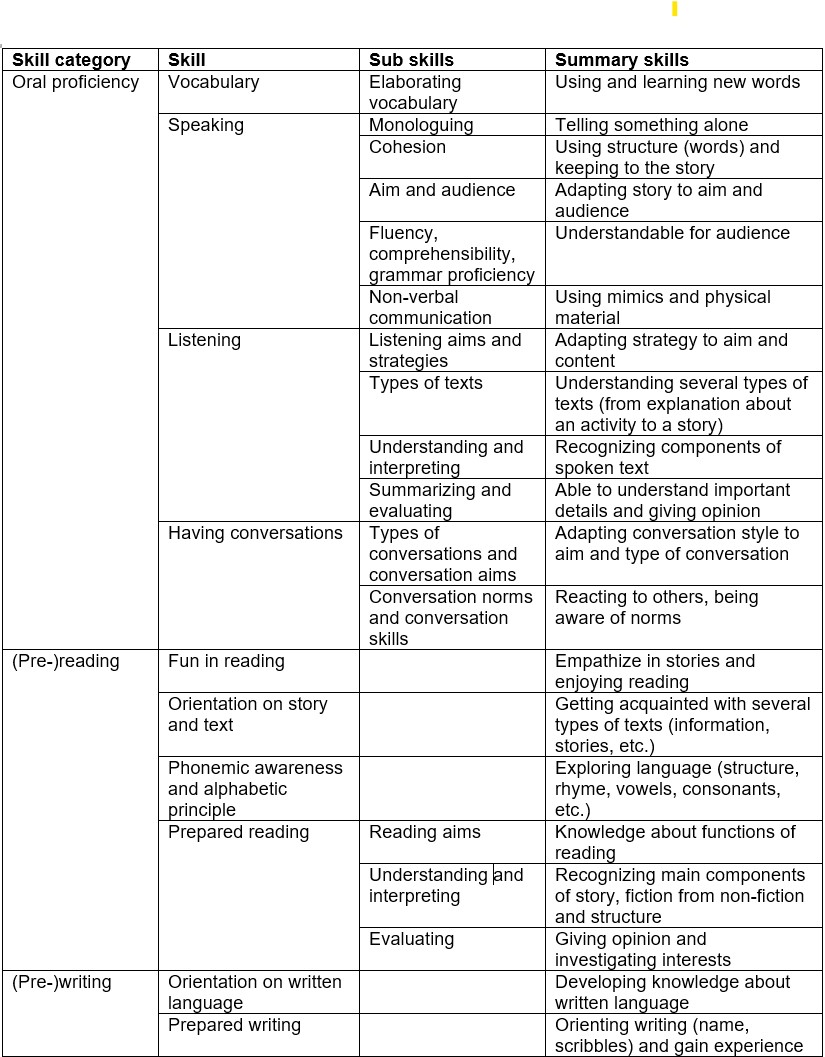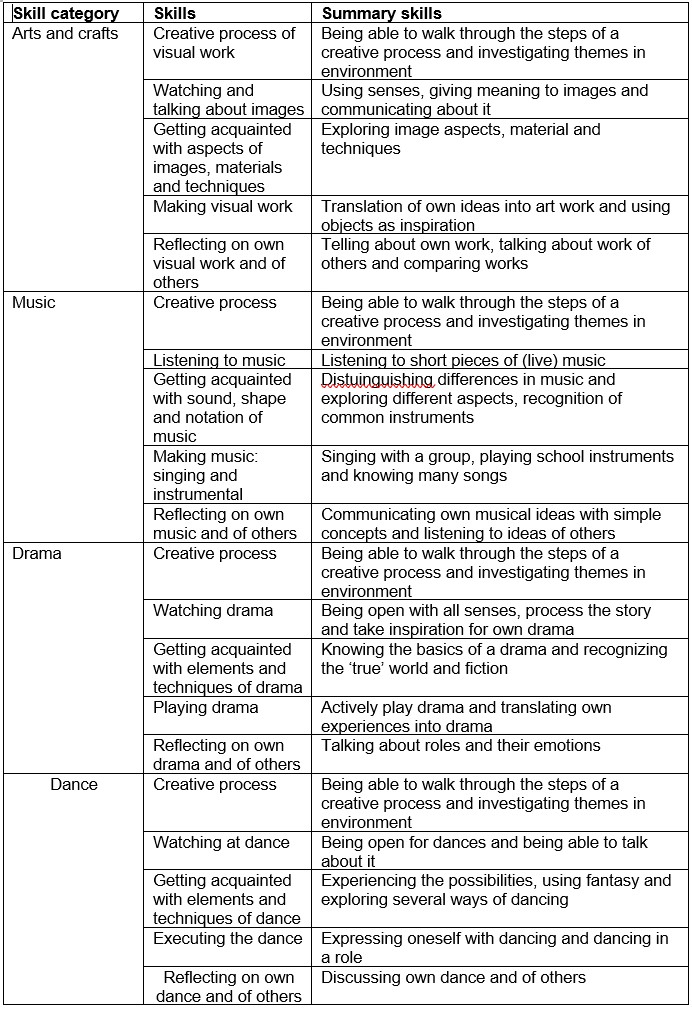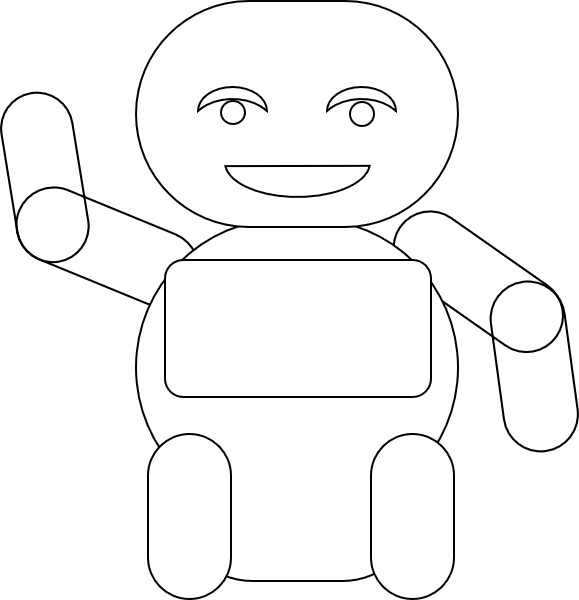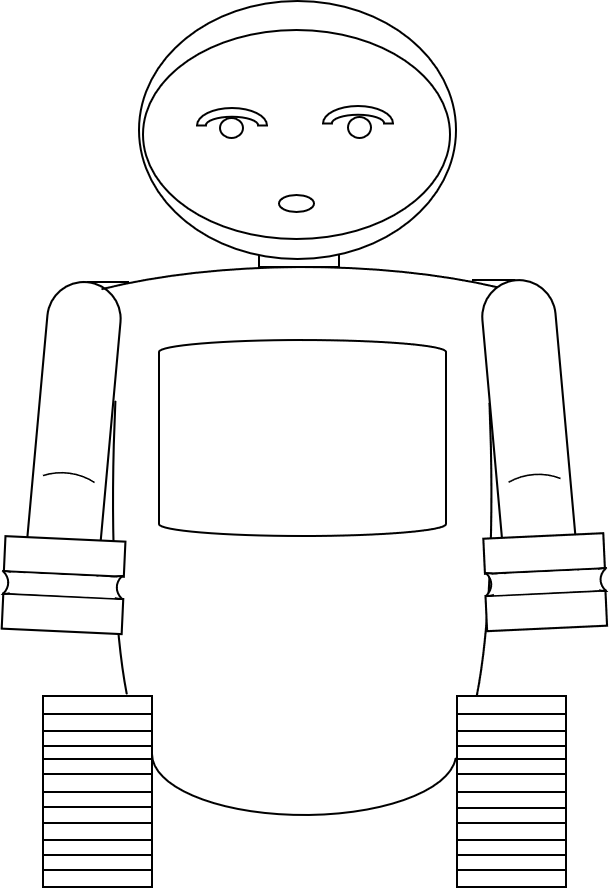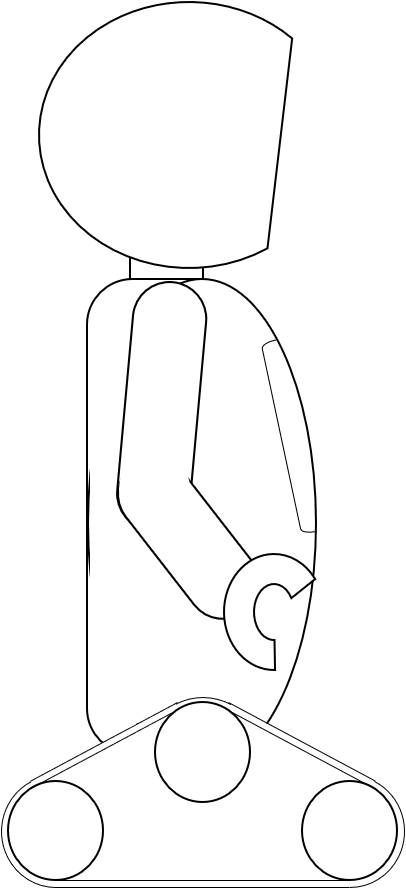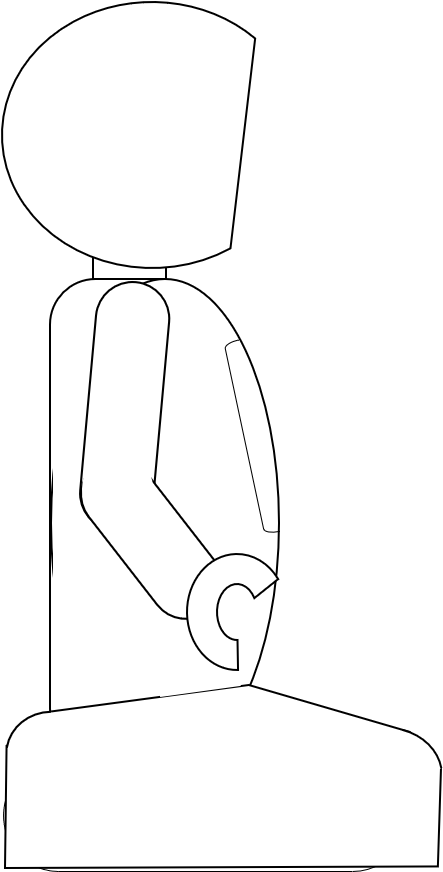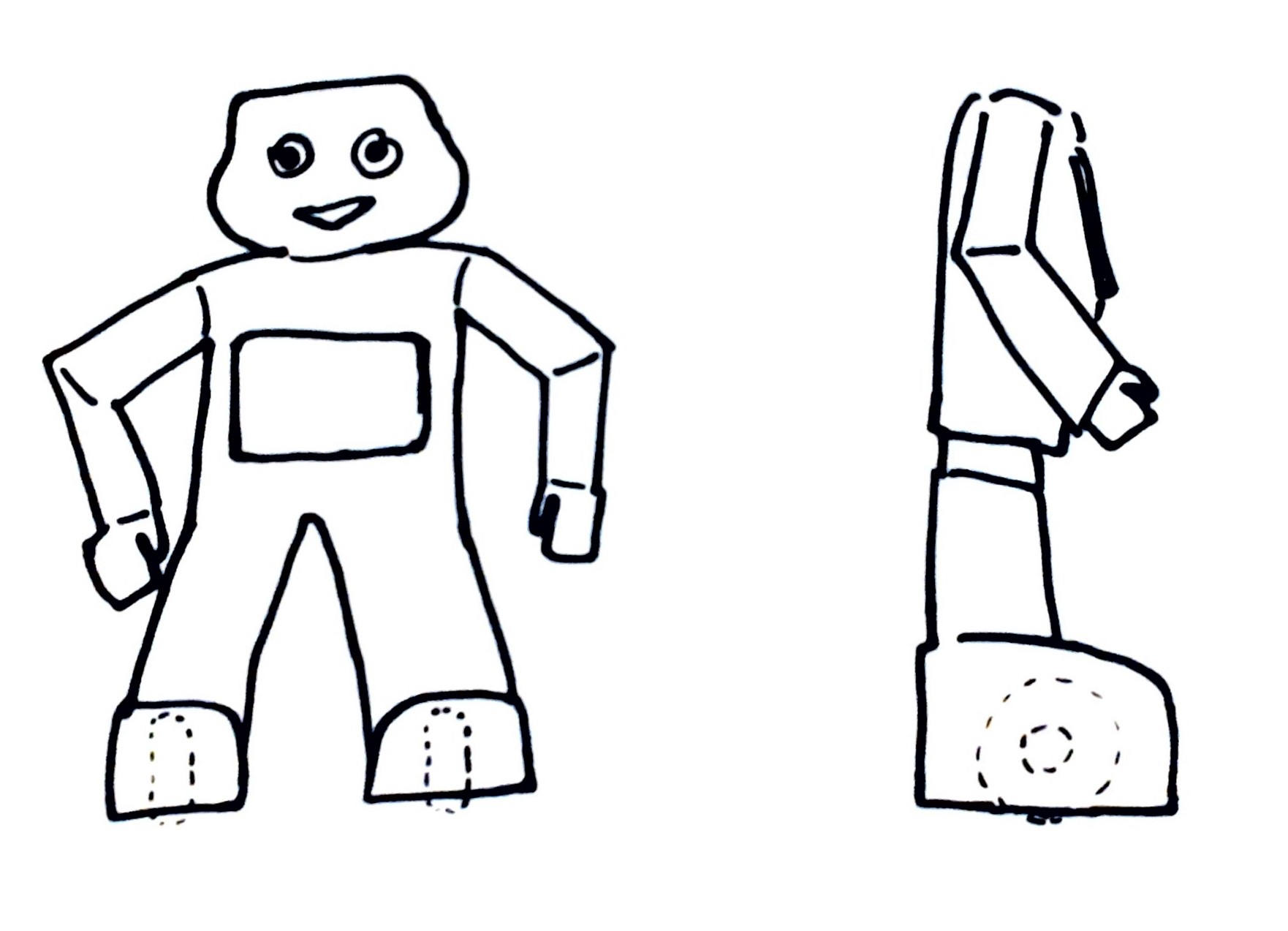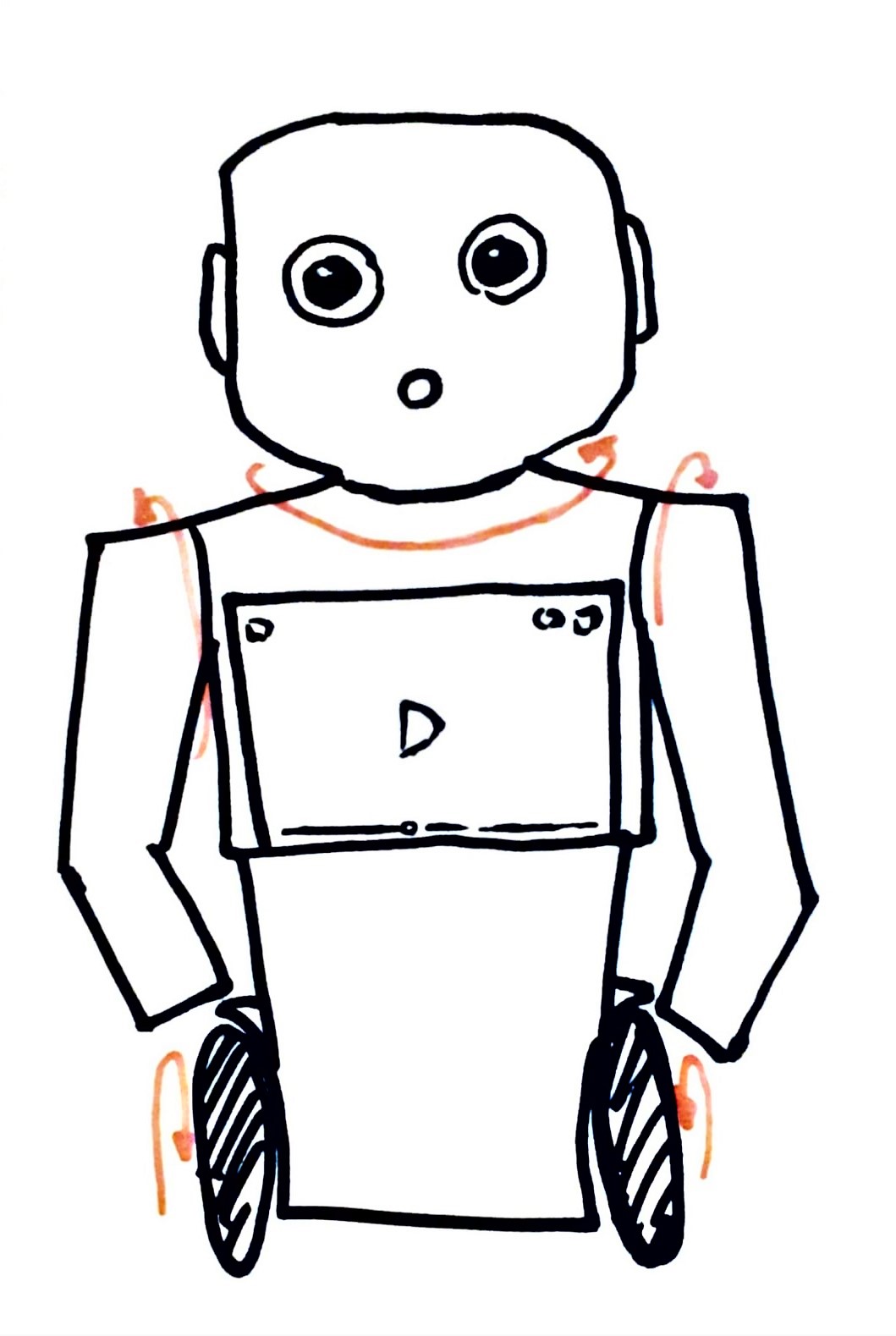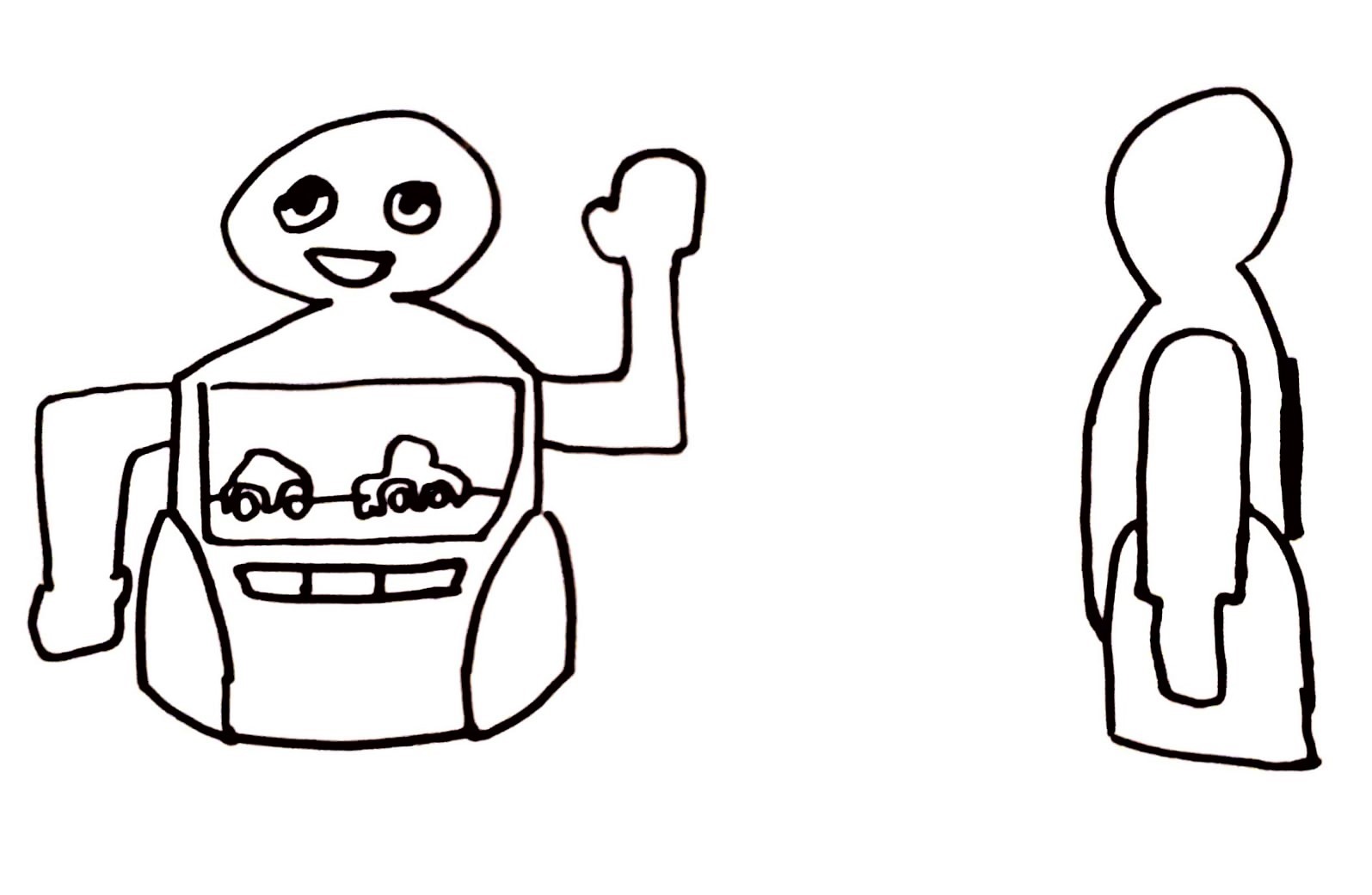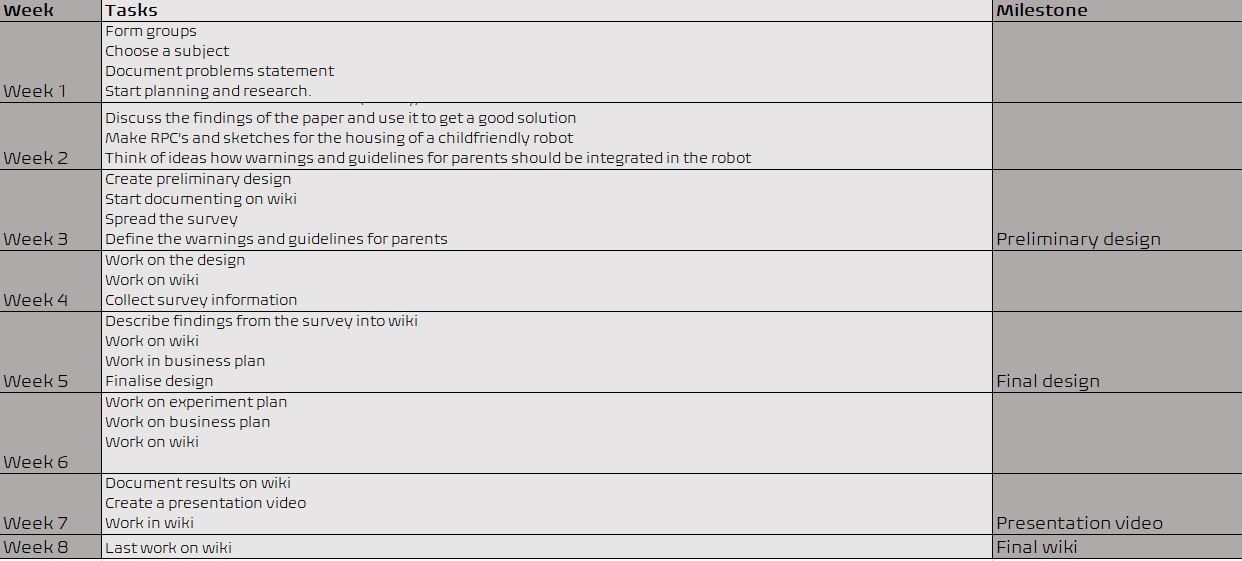PRE2020 3 Group9: Difference between revisions
TUe\20182065 (talk | contribs) |
TUe\20182065 (talk | contribs) |
||
| Line 900: | Line 900: | ||
| Hidde Huitema | | Hidde Huitema | ||
| 9 Hours | | 9 Hours | ||
| Figuring out the potential uses of URDF and simcenter for this project. Learning the basics of URDF | | Figuring out the potential uses of URDF and simcenter for this project. Learning the basics of URDF. Working on the list of deliverables | ||
|} | |} | ||
Revision as of 10:16, 1 March 2021
Groupmembers
| Name | Studentnumber | Department | Responsibility |
| Emma Allemekinders | 1317873 | Mechanical engineering | Technical drawing and business plan |
| Emma Höngens | 1375946 | Industrial Engineering & Innovation Sciences | Guidelines for parents and software plan |
| Paul Hermens | 1319043 | Mechanical engineering | Business plan and model of path planning |
| Hidde Huitema | 1373005 | Mechanical engineering | Model of path planning and list of materials |
| Jos Stolk | 1443666 | Mechanical engineering | Technical drawings and software plan |
Introduction
Problem statement
Due to the COVID-19 pandemic, a lot of people have to work at home. As children are also more at home, it is hard for parents to combine private life with work, especially meetings. Therefore, there should come a child-friendly robot that keeps children busy so parents can have their meetings.
Robot description
Deliverables
| Deliverables |
|---|
| Technical drawings + Evaluation of stresses and strength of robot in NX to validate whether the robot is child-proof |
| Model of path planning of the robot by making use of the Robot toolbox in MATLAB. By making use of SLAM the robot can avoid riding against the child or other things in the room. |
| Software plan with description of the games that should be implemented, privacy, data safety, voice recognition, face recognition etc. All arguments based on RESEARCH and results of the survey. |
| List of materials |
| Business plan: List with costs of materials to get a final selling price to evaluate with a survey whether this selling price is viable |
| Guidelines for parents: Since the robot is a toy it should have a description for safe use for a child |
Outline wiki
This wiki describes how the robot Rubby is created. The chapters guide you through the development process. Description robot
This chapter describes which requirements robots for children need to satisfy. This gives a clear view on the research field. Rubby
This chapter describes the robot that will be developed. It also illustrates the use of Rubby in daily life. User
This chapter describes the group of users and the specifications. User needs are also described here. Naam
This chapter describes what the robot should contain at the end of the project and how these RPC's translate themselves to the robot.
Deliverable 1: Model of the path planning
Deliverable 2: Technical drawings + evaluation of robot etc. in NX
Deliverable 3: Software plan
In this chapter the end product of the software plan will be described.
Deliverable 4: List of materials
Deliverable 5: Business plan
In this chapter the end product of how much the robot will cost is described.
Deliverable 6: Guidelines for parents
In this chapter the end product of how the robot should be used is described.
Conclusion
In this chapter the end product is discussed, the process is evaluated and future development is described.
Appendix
In this chapter you can find all elaborating material that is used for the development of the robot.
Description robot
RPC's for this project
| Requirements |
|---|
| The Robot should be able to move itself with a speed of 4km/h while preventing collisions with objects in the room |
| The Robot should have two arms which are able to rotate about 180 degrees and move spherically |
| The Robot should be able to be wireless (on battery not with a wire). |
| The Robot should have a child-friendly casing and shape |
| The Robot interface should be placed on itself where the child can reach it well |
| Guidelines for parents: Since the robot is a toy it should have a description for safe use for a child |
| The Robot should include an emergency button located on the Robot to stop the robot functions |
| The Robot should have voice-recognition sensor on itself where at all time voice can be recognized. |
| Preferences |
| The robot should be as cheap as possible |
| Constraints |
| The Robot size should not be longer than a child of 4/5 years old |
RPC's for the software engineer
| Requirements |
|---|
| The Robot should be able to charge itself when the battery percentage is 5 percent. And it should go back to its charger when the Robot is turned “off". |
| The Robot should have some sort of interface on which entertaining games/educational games can be played by the child |
| The Robot should be able to make sounds, including pre-programmed talks like “Well done” and music |
| The Robot should be able to provide: Physical games, entertainment games and educational games |
| The Robot should be able to send a signal to the parents when something is wrong with the child |
| The Robot should include an emergency button located on the Robot to stop the robot functions |
| The Robot should be able to detect when the child is bored / can’t keep its concentration |
| The Robot should have voice-recognition for its pre-programmed games |
| Preferences |
| The Robot should be able to detect emotions of the child |
| The Robots gender should be able to be chosen by the user |
| Constraints |
| The Robot should not tell the child what to do or not |
| The Robot should be designed in such a way that the data is safe and no user data can leak |
Entertainment functions
[background]
- Interactive interface to enable entertainment for the child
- Tablet/ screen
- Voice commands
- Singing songs
- Check if the child is still paying attention (be aware of the short attention span )
Educational functions
The educational aspects of the robot are based on already existing techniques. In several studies, robots that have such educational functions, were implemented in a children’s environment to investigate the impact of the robot on the children. Examples of these existing robots are Robovie, QRIO and IROBI [QRIO; IROBI]. Two Robovie robots have been implemented at a primary school in order to investigate whether they could form relationships with children and whether these children might learn from them. Results from this study, along with those of the studies performed with QRIO and IROBI, showed that robots are actually able to teach kids the English language [Robovie(1); Robovie(2)], can achieve strong social bonds with toddlers for a long period of time [QRIO] and can increase the learning interest and academic achievement [Breazeal].
A few important conditions are needed to achieve this. First of all, the more predictable the robot is, the worse the quality of interaction. This means a robot should ‘grow’ with the child in order to increase the effectiveness of learning and communication. Secondly, it is preferred that a robot is adapted very well to the personal characteristics of the user; since each child has a different way and pace of learning. Furthermore, appearance, behavior and content of the robot are the three main factors that have impact on the robot’s effectiveness. Finally, an important note is that robots should do not replace parents, tutors or teachers; they are only for supplementing them in what they already do. [Breazeal]
As a conclusion, robots with an educational function have a significant added value. Children’s language skills can be improved and especially their motivation to learn increases. Verbal interaction with the child to learn words appears to be a relevant and feasible function, and also playing memory games is a feature of a robot that already exists [Breazeal]. The extra educational function of writing check increases the diversity of learning areas; Writing is a more active, whereas language learning is a more unconscious process.
Rubby
Description
Rubby is a robot solution that helps parents focusing on their work at home without having to give intensive attention to their child, especially in times of working at home due to the Covid-19 pandemic. The robot Rubby keeps the child busy by functioning as a playmate while taking the desires and attention span of the child into account.
The Rubby is a robot of around half a meter high. that is able to move around by means of wheels. It is able to detect motion of the child and if necessary, the robot can move slowly as well. Rubby has arms and also a body on which a tablet is mounted. This tablet is used as an interface on which the child can play games. Rubby is able to interact with the child in several ways. First of all, it can respond to the child's speech. Secondly, it can speak to the child, which is for example used in telling stories, improving the child’s vocabulary. Finally, the interaction is enhanced by the movements of Rubby, as it can move the arms and roll back and forth. The tablet on the robot’s body can be used in an entertainment as well as an educational way. The change in these kinds of interaction enhances the social connection between Rubby and the child. The robot takes into account the loss of attention of the child by asking whether or not he should switch to a different game.
Scenario
It is Friday morning, around 8.30 AM. Ava wakes up because her father David is opening the curtains in her room. ‘Good morning sweetheart’ he says to her. David let her sleep later on than on school days, so he could already do some work. Today he has some important meetings and he has a deadline in the afternoon, so it is going to be a busy day. But first he breakfast with Ava and goes to the supermarket to do some shopping for the day and the coming weekend.
At 10.00 AM, Ava and David are back from the shop. Now, the day can really begin. David opens up his laptop and starts working from the table in the living room. Ava sits in the living room at the carpet and starts playing with her dolls. After half an hour, she starts to get bored. David gives her some fruit and tells her that he has a meeting the next hour. ‘Yes, then I can play with Rubby’ she says and she wonders what the robot has in mind to do for her this time. When David would have announced a meeting 3 months ago, Ava would be disappointed as she had to be silent all time and she got bored. Nowadays, when her father should not be disturbed by Ava she can hang out together with Rubby, a robot that acts a playmate for toddlers so their parents can work or meet without being disturbed.
After taking her last little piece of fruit and sip of her drink, David get Rubby out of the charger in the corner of the room. He puts the robot on the carpet, turns it on and set up the robot for an hour to an hour and a half. “See you in an hour darling” he says to Ava, sits down at the table and puts on his noise-cancelling headphones.
“Hi Ava, I am Rubby I am not a human like you and your father, but I am a robot” … says to Ava. “Hi Rubby, what are we gonna do today?” Ava asks the robot. “We start with a counting game” and the tablet on his belly light up. After 10 minutes he asks Ava “Do you want to go something else?”. “Yes” she answers. She learned that she can only use little commands for the robot and she has to pronounce it clear. When you talk with humans you can have real conversations, so she knows from this that Rubby is a robot.
“Now, we will do a puzzle.” The game on the screen on his belly change and Ava starts putting pieces on the right spots. After 10 minutes Rubby asks again if Ava want to something else, “no” she answers and continues with the puzzle. After 5 minutes he asks again and Ava indicates she want to do something else. “Let’s do some exercise Ava!” Rubby says and he starts to explain what they will do. With his arms the robot indicates what Ava has to with her arms and with his wheels he shows the direction of the steps Ava has to take. After 10 minutes Rubby says “Let’s do a color game” and the screen on the belly lightens up again. This gets on for coming 40 minutes and then David’s meeting is finished.
David finds it nice that his daughter does not get bored while he has a meeting and that he is not distracted. It feels good to know that Ava gets a variety of activities to do by … alternated with entertainment, learning and physical tasks.
After long meetings he always takes a walk, so today he takes a walk with Ava. After their half an hour walk, they lunch together. After lunch Ava should take some rest and she read some picture books for half an hour. Then she can watch the television for half an hour. After this she can play with her dolls or something else. This afternoon, David has to finish something important and he also has a meeting. Fortunately, Rubby supports him with keeping Ava busy for an hour and a half.
Due to Rubby David has an effective working day. And also due to Rubby Ava had a nice day with a lot of fun activities. Before they had Rubby as a support, David had to work in his free time to catch up with his work. This weekend, when the whole family is home, they can do a board game or watch the television together with David.
User
User specifications
In this section, the target group will be defined and specifications of these users will be given.
Development children
Development 3-4 year
| Kind of development | Description | Robot requirement | |
|---|---|---|---|
| Physical development |
|
This safety can be provided by giving guidelines to parents and having clear what can happen. | |
| Intellectual development |
|
| |
| Attachment development |
|
||
| Social development |
|
Implement a positive(complimenting) stimulating part in the robot: "Well done etc ” | |
| Language development |
|
|
|
| Play development |
|
Development 4-5 year
| Kind of development | Description | Robot requirement | |
|---|---|---|---|
| Physical development |
|
Maybe let child do exercises (imitate robot) | |
| Intellectual development |
|
||
| Attachment development |
Is already quite independent |
||
| Social development |
|
What should a robot do if the child does not listen? | |
| Language development |
|
||
| Play development |
|
|
Development 5-6 year
| Kind of development | Description | Robot requirement | |
|---|---|---|---|
| Physical development |
|
Do something with ports? | |
| Intellectual development |
|
Make a game with simple words | |
| Attachment development | |||
| Social development | Wants to be independent | ||
| Language development | Pretty good with words | ||
| Play development | Can work multiple days on a drawing |
Content school
In Appendix D, an overview what is learned in year 1 and 2 of primary school in the Netherlands can be found. Many aspects that are (usually) learned in kindergarten are based on social and emotional interaction. Existing technologies are not yet able to completely support humans in these interaction and this is especially the case for younger children. In the table below there can be found on what components of primary school content Rubby can build on.
| Discipline | Skill | Learning material |
|---|---|---|
| Dutch |
|
|
| English |
|
Make a game with simple words |
| Mathematics |
|
|
| Orientation to yourself and the world |
|
|
| Artistic orientation |
|
|
| Physical activity | Moving on music | Dancing, rhythm of music |
Educational content
User Needs
Decision making children
In parent to child interaction there is a natural balance between the control of the parent in comparison to the child’s own demand for independence (Lundberg, 2007). Which means even parents won’t always be able to guide their children to what the parents want for example playing with blocks. This balance depends on the age. Young children have way less control over their activity and independence than older children. If the robot is used, the same effect will occur. The robot will not have constant control over the activity of the child. If a child seems to want different interactions the robot can use this information. The child could want to interact with the room or environment or maybe the robot with another application. As young children have an attention span of 10-15 minutes, it is important to change some things up after such a time span (Torta, 2012). This is important to increase the effectiveness for the parents of working or doing something else without using a lot of focus to watch your child. Aside from the focus benefit for the benefit, Rubby can also increase educational areas using games. From research (Herodotou, 20188) children using in this study angry birds regularly showed positive impact on the maths comprehension.
Name
RPC's
Functions for robot
Safety
- Motion control for the robot, to keep an eye on the child when it is moving around. [Robot following] shows that the following behaviour can be used to keep the child in view and therefore ensure proper functioning of the robot at all times.
- It should be possible to move slowly to not be dangerous. This in combination with a soft material will drastically decrease the change of dangerous operation. [Child robot] shows faster movement on its own is not as bad. It is a higher mass with fast movement that creates a worse impact if in contact with a child. If the drive mechanism is moved towards the core of the robot, the weight of the arms can be reduced which requires less torque, and will therefore be safer.
- Observe dangerous objects in close range of the child and notify caregivers. This is done to increase the safety of young children. As children are very curious they can interact with sharp, hot or other kind of dangerous objects without knowing it. If the parent is busy with other activities they wouldn’t see it without a warning of the robot.
Entertainment
- Interactive interface to enable entertainment for the child. [Tablets children] shows children can be entertained rather easily by a tablet. In our case it would have also voice capabilities which could make it a more natural interaction and possibly more entertaining.
- Tablet/ screen
- Voice commands
- Singing songs, in [Music robot] the children were often not only entertained but started moving or dancing to the music. This stimulated not only musical hearing but also some natural exercise.
- Check if the child is still paying attention (be aware of the short attention span). This can be used to switch up the current activity. If for example they are/were enjoying music or playing games but then lose interest which can be derived from their expressions and body language. Then the robot nanny can ask if the child would want to do something else. Children are able to use a tabled independently from a very young age [iPad use children]. The child will therefore be able to control the tablet by themselves and will therefore be able to choose their activity independently and according to their own attention span. When the robot senses that the child is fully distracted from the tablet however, it will prompt the child to do another activity with the robot. It is stated in [Grabbing attention] that this is most easily achieved by sound cues. Waving gestures proved to be the second most effective means of attracting attention. This can be achieved by moving the arms attached to the robot.
Education The potential benefits of using robots for educational purposes has been shown in [Robot use for childcare], [Robots as social partners] and [socialization toddlers]. It is therefore desirable that a robot nanny can also carry out educational tasks. These following tasks will be carried out by Rubby:
- Talking to the child. It is shown in [Talking to children] that speech directly targeted to children plays a large role in their future development. This is a task that can easily be carried out by the Rubby robot. It can read books and tell stories to the child to stimulate the development of their vocabulary.
- Games for development of memory and numerical skills. Passolunghi and Costa have shown in [Educational games], that playing specific games can greatly improve a child’s working memory and numerical skills. These games can be implemented in a tablet for example and can be played by the child.
- Check writing. It is argued in [Escribo games] however that playing games on a platform similar to Squla, significantly increased the reading and writing skills of preschoolers. This is a task that can also be carried out by the Rubby robot. A tablet can be implemented on which the Squla games can be played and the robot can give positive reinforcement to stimulate playing these games.
Not sure (for questionnaire) We are not sure whether the following functions will be implemented in the robot, the questionaire will show whether these functions are desired.
- Physical entertainment. Trost et al. argue in [Physical activity overweight] that there is a strong correlation between overweight status and physical activity in preschool children. More physical activity in the form of dancing, playing catch and other games will therefore lead to less chance of a child becoming overweight. However, Timmons, Naylor & Pfeiffer argue in [Physical activity preschool] that there is no real correlation between the health of a pre-schooler and their physical activity in the long term. Nevertheless, physical activity is never a bad thing and could be stimulated by the Rubby robot. It is important to initiate physical activity that the child considers fun however, as also mentioned in [Physical activity preschool]. This can be supported by the moving wings/arms on the Rubby.
- Restraining the child for safety. As stated by Sharkey & Sharkey in [Crying shame of robot nannies] it might be desirable for a robot nanny to physically restrain a child when he/she is about to do something dangerous. This might not be desirable however, since restraining a child is a slippery slope and might lead to unwanted behavior of the robot.
Requirements for robot
Technical requirements
- Camera (for privacy only process local and send just notifications over the internet to the parents or care givers). This way a lot of safety features can be made available like described above.
- Screen with touch
- Microphone (Also local processing)
- Sensors to make path planning possible
- Lidar, possibly very expensive
- Cameras, could need a lot of processing
- Proximity sensors
- Maybe the best solution, a combination of cameras and proximity sensors.
- Motion control
- Walking would be way to expensive and difficult for the purpose
- Rolling with 2,3 or 4 wheels will be relatively easy. Tracks could also be used. To improve the usable terrain of the robot tracks could be used as they can keep traction on surfaces like carpets or a wet floor. Wheels are quite reliable and would create less noise
- Two arms which are able to rotate about 180 degrees and move spherically to introduce playfulness and connected interactivity with the child
- Batteries with automatic charging (at night or if not in use)
- Processor to run software, path planning, facial recognition as well as emotion recognition. The heaviest task is the path planning. This would use as input all the sensors to then come to a resulting path to or around the child to accomplish a goal.
- Emergency button located on the robot to stop the robot functions to prevent accidents. As well as a remote emergency button from the network.
- Software to facilitate safety, entertainment and education purposes
- Voice recognition
- Text to speech, more robot-like voice as it is not a humanoid and in Dutch. Possibly multiple voice sound options to increase acceptance of the robot
- Games as described above
- Path planning
- Updating of software (possibly over the network), not only functions but also security. This is also a important part as bad software can in this case result in an almost useless robot.
Camera or no camera The questionnaire will show whether or not the use of a camera is desired. Different technical requirements for a robot with and without camera are given below:
- Camera
- One higher resolution camera would be used for facial recognition, emotion recognition and possibly body language observing. It would also be used to keep the child from dangerous situations.
- A couple, 3 or 5 cameras located at the sides and back to make path planning possible. These can be lower resolution as bigger objects are the most important part for path planning.
- No camera
- A camera might not be desirable due to privacy issues.
- The child will be given a bracelet which serves multiple functions:
- It lets the robot know where the child is. This will enable the robot to follow the child.
- The bracelet can monitor bio signals and use those to recognize emotions of the child.
- The robot will use Lidar technology and proximity sensors (that can track the bracelet) To navigate around the house
- The biggest downside of not using a camera is that the monitoring capabilities of the robot will then be severely limited.
Deliverable 1: Model of the path planning
Deliverable 2: Technical drawings + evaluation of robot etc. in NX
Design conception
In order to design a robot, and especially its exterior appearance, several aspects are to be taken into account. Studies have shown the functions and shapes of a robot are crucial for the effectiveness of interaction between the robot and its user. This is the starting point of the design of Rubby. Sketches are made of different components of the robot as well as of the robot as a whole. Here the RPCs are taken into account in order to comply with the determined requirements.
Additionally, the following foundings were important with regards to the external design of Rubby:
- Sound effects: The addition of sound effects is the most effective and feasible way to keep the user’s attraction to the robot. [sound addition]
- Eye-contact: Eye-contact does not necessarily improve the attention of the participants. The robot’s gazing behaviour may be suited in cases where the visual attention is already on the robot. [eye-contact]
- Essence of shape: The shape are and interactional functions of a robot are important for the development of personal robots. [shape importance]
- The importance of human-likeness: Robots need a moderate level of human-likeness; however, robots still need to be easily distinguishable from human beings. [human-likeness]
- Antropomorphic appearance: A moderate level of anthropomorphic appearance is required combined with appropriate social cues. [antropomorpic appearance]
- Children tend to attribute intelligence, biological function and mental states to a robot. [attribution]
- Humanoid features: A few visual human-like features can achieve the elicitation of children’s preferences. [humanoid features]
- General appearance: A humanoid robot appearance is predominantly preferred over a robot with pure mechanical appearance.[general appearance]
- Impression of a robot: The initial impression and evaluation of a robot is essential. [impression]
Based on this, the following design choices regarding the external design of Rubby were concluded:
- Basic shape of the robot should be similar to that of a human being.
- The addition of sound effects: music sounds and speech.
- The addition of arms. These arms can turn in order to increase the level of human-likeness and to increase the attention attraction.
- The addition of a head. To ensure the robot does not look too much like a human being, the incorporation of a moving mouth when speaking is left out.
- Concerning the eye contact, ‘fake’ eyes can be added, however physically rolling and blinking eyes are left out, since this might work counterproductive.
- The addition of wheels. This emphasizes the robotic nature instead being a human. The movable aspect is important to improve the emotional response of the child to the robot.
Taking these aspects into account, together with the RPCs made, several sketches and outlines are made to visualize possible solutions.
In Appendix H, an overview of these sketches can be found.
TO DO: ADD PRELIM DESIGN, AND FINAL DESIGN +CAD MODEL EVALUATION
Preliminary design
[COMBINE SKETCHES INTO ONE DESIGN WRT. RPCs]
Final design
Deliverable 3: Software plan
Deliverable 4: List of materials
Deliverable 5: Business plan
Deliverable 6: Guidelines for parents
Conclusion
Conclusion
Discussion
Future work
Appendix
Appendix A: Persona's
The majority of the Dutch households with children are led by two parents. However, more than 10% of the households with children is led by one parent (80% of the cases woman) (Volksgezondheidenzorg.info, 2019). To give a good view on the users of the Toddler Nanny, people of 2 households are described below. In one-parent households, the majority has one child (Nederlands Jeugdinstituut, 2020).
Melissa Melissa is a female of 31 years old. She is not married and has a son, Noah, of 3 years old. They live together in an apartment at the edge of a town. She likes to walk with her son to the playground nearby their home, play with him and watch animation videos with him. Once in a month, she meet with her friends in a restaurant or a bar. Melissa’s mother babysit for Noah.
Melissa works for five days a week as a secretary in an advertising agency. Before the COVID-19 pandemic, she worked for four days at the office and on Friday from home. Nowadays, she works from home five days a week. As Noah is not allowed to go to kindergarten every day, he is also at home for several days a week. She finds it hard to concentrate with Noah at home too: he attract a lot of attention and makes a lot of noise. Because she cannot do much on her job during the day, Melissa works until late in the evenings to complete her work.
Noah Noah is a boy of 3 years old. He lives with his mother Melissa in an apartment at the edge of town. He likes to hear stories read by his mom, play with his toy cars and build towers from building blocks.
Noah does not go to school as he is too young. He went to kindergarten four times a week before the COVID-19 pandemic, but nowadays he is at home for multiple days during the week. He tries to talk with his mom Melissa, but she is grumpy when he does as she has to work. She parks him in the same room as she is with a box full of toys. He plays with his color puzzles and other toys, but after ten minutes he get bored and starts another activity. He uses sounds while playing and his mother get annoyed by this. A few toys later, he starts asking questions to his mom, but she does not answer and talks to other people on the screen. He tries to play again with his toys, but after a while he tries again to attract the attention of his mother. It does not work, she gets angry and puts him in a chair so he can watch television and she is not disturbed by him.
David David is a male of 44 years old. He is married with Karin, a general practitioner of 39 years old. Together, they have two children: James, a boy of 8 years old and Ava, a girl of 4 years old. They live in a family home in a village surrounded by meadows.
David works from home, at his home office, for four days a week. He is a logistic consultant and works with companies from over the whole world. He has a lot of conference calls in a week and there is also a lot of paper work to be done. Ava, his little daughter, is at home at Friday and Wednesday afternoon. She can be disturbing, because she wants to have attention from her father David and she is not able to keep herself busy with hobbies, like James is. Kindergarten is not possible for Ava as this only takes place a few villages away. David hopes that there will be a technology that supports him with caring for Ava, so he can continue working. Ava Ava is a girl of 4 years old. She lives in a family home with her brother James and her parents David and Karin. She goes to school 4 days a week. At Friday she is at home with her father, because she and the other toddlers of her school are free at that day. Ava likes to play with dolls, cars, paint and dance with her family members.
When she is at home on Wednesday afternoon and Friday, she feels bored. She does not know what to do on these days. James goes to his friends, the hockey club or is at school, so she cannot play with him. On these days she wants to play with daddy, but he has to work all day. When she goes to her father, he is talking to other people on the screen and he has not time for her. Sometimes he get angry when she chats with him during work hours.
On these days, she has to keep herself busy the whole day. David, her dad puts her in the living room or in his office with her toys. She always plays herself with puzzles, read her books and play with toy trains. After a while, she asks her father if she can watch the television and he always says yes so she does not disturb him. However, watching television for a long time is boring, she thinks. So she hopes that there is someone or something that can play with her when she is at home.
Mark Mark is the 39-year old father of Eva. He works hard at ASML as mechanical engineer. During the COVID-19 pandemic he works from home. However his daughter Eva also is home because school is online. Now Eva has to play on her own because he has to work during the day. Therefore, Mark hopes that technology will help entertaining and educate his child when he is busy.
Eva Eva is a girl of 5 years old. She lives with her parents Mark and Julia. She goes to school 5 days a week. However on Wednesday and Friday she is free in the afternoon. Because of the COVID-19 pandemic she is home because school is now closed. She always plays by herself with puzzles, read her books and play with toy trains. She likes to run and play a lot. That's why her parents bring her every Saturday to the ice rink to skate. However when her parents are working she feels alone and bored. She likes to learn new things, but this is hard for her to do on her own. Therefore, she hopes that there is someone or something that can play with her when she is at home and teach her new things.
Appendix B: User needs
Appendix C: Scenarios
Appendix D: Consent form survey 1
Information form for participants
This questionnaire being part of a design course is performed by Emma Allemekinders, Paul Hermens, Emma Höngens, Hidde Huitema and Jos Stolk, students under the supervision of Elena Torta of the Control System Technology group at Eindhoven University of Technology.
Before participating, you should understand the procedure followed in this study, and give your informed consent for voluntary participation. Please read this page carefully.
About this study
This study has the goal to examine what the requirements of parents would be for a robot that assists parents in combining work from home and children. You will fill in this survey with questions about the functions of such a robot.
This study will take 5 minutes to complete and does not involve any risks.
Voluntary Participation
Your participation is completely voluntary. You can stop participation at any time. You can also withdraw your permission to use your data up to after completing this survey.
Confidentiality and use, storage, and sharing of data
This study has been approved by Elena Torta, teacher of the bachelor course Robots Everywhere of Eindhoven University of Technology. In this study experimental data will be stored. The anonymized dataset that, to the best of our knowledge and ability will not contain information that can identify you, will be used in this research and stored on a TU/e OneDrive account.
Further information
If you want more information about this study, the study design, or the results, you can contact Emma Höngens (contact email: e.hongens@student.tue.nl). You can report irregularities related to scientific integrity to confidential advisors of the TU/e, whose contact information can be found on www.tue.nl.
Certificate of consent
By starting this study, I indicate that I have read and understood the study procedure, and I agree to voluntarily participate.
Appendix E: Questions Survey 1
Introduction robot
Rubby is a robot that is made to support parents in focusing on their work at home when their young, school-going children (4- and 5-years old) are around. When a parent has a meeting or another important activity that requires a peaceful work environment, Rubby can keep a child busy during these moments. Rubby moves by wheels, has arms and a body on which a tablet is mounted. It is able to detect the motion of the child. The tablet, motion detection technologies and interaction technologies make it possible for Rubby to entertain the child with games, teach new things (broading vocabulary, learning to write, etc.) and do physical activities like dancing. Every activity has a span of 10 minutes ( meet the limited attention span of 4- and 5-year old children) and when finished, Rubby asks the child if it want to continue or have another activity. In this way, a child has various activities to do in the time a parent does not have time and parents will be able to work without too many disturbances.
- Do you think that Rubby would be able to support you as a parent with working from home during the COVID-19 pandemic lockdowns?
- Not at all
- Slightly
- Somewhat
- Really well
- Why/why not?
- What are the most important features of a supporting robot like Rubby do you think?
- Interaction of the robot with the child
- Entertainment of the child by a robot
- Assisting the child in learning new things
- Motivate the child to do physical activities, using the robot’s movements
- It does not matter how the robot keeps the child busy, as long as parents can work without too many disturbances
- Different, namely ….
- Why?
Only for parents that have/had at least one child during one or two of the lockdowns of 4 or 5 years old.
- Do you think that your child(ren) would (have) like(d) to play with Rubby?
- Yes
- Sometimes
- No
- Why?
- How long is your child able to concentrate on something?
- Do you think that your child will be able to keep him/herself busy with the variety of activities or Rubby when you are working?
- Not at all
- Slightly
- Really well
Questions about safety improvement(s) of the robot
This first prototype of Rubby is focused on keeping children busy so their parents can work. Rubby and the child are in the same room as the working parent is responsible for the safety of the child.
- Do you want to have your child in another room than you are with a robot like Rubby?
- Yes, that’s fine for me
- Yes, but only if there are extra safety measures taken (like a camera in the room or guidelines for a safer room)
- No, never
There are several technologies that can keep an eye on a child when interacting with a robot like Rubby. The most common is adding a camera to the robot so parents can look at their child. This has advantages like good monitoring, but a camera also bring disadvantages with it. For example the privacy of the child and the data security.
- Do you think adding a camera to Rubby is a good idea?
- Yes
- Yes, but the camera only should be on when the parent activate it
- No
- Why?
There are also other ways to monitor your child when using Rubby, but these technologies are still in the development phase and do not work optimally. Examples are an emotion bracelet and voice recognition. When the child wears a bracelet, emotions can be measured on basis of bio signals Voice technology also is an option. When the child cries, a signal can be sent to the parent.
- What would you add to Rubby for safety when parent(s) and the child are in a different room?
- A camera
- A bracelet with bio signal technology
- Voice technology
- Nothing
- Different, namely:
- Why?
Last questions about the robot
- Do you have any concerns towards Rubby? Please write them down below.
- Do you have any tips/recommendations for Rubby? Please write them down below.
Questions about children
- How many children do you have?
- How many of your children are boys?
- How many of your children are girls?
- In which age range are your children? (Multiple answers possible)
- 0-3
- 4-5
- 6-10
- 11-15
- 16 years or older
Demographics
- How old are you?
- To which gender identity do you identify most?
- Female
- Male
- Not listed
- Prefer not to answer
- What is your highest obtained education level?
- Primary school
- Secondary school
- MBO
- HBO
- University
- Not listed, ...
- Where are you come from?
End Survey
Thank you for participating in this survey about the supporting robot Rubby. Is there anything you want to add or let us know?
Appendix F: Results
Data
Data analysis
Appendix G: School content
In the Netherlands, education is organized by means of core objectives (SLO, 2020a) per discipline. These have to be obtained by children when they finish primary school. How schools organize their education is free, as long as the core objectives are obtained. This means that schools follow different learning processes and it cannot be said what is learned per year.
However, TULE, an organization consisting of education experts, describes which steps in the learning process has to be taken to obtain the core objectives. These sub objectives are divided per periods of 2 years. This project focusses on children that go to kindergarten, so the information about ‘group 1-2’ (year 1 and 2) is of interest. The objectives focusses on Dutch, English, mathematics, orientation to yourself and the world, artistic orientation and physical education (TULE, n.d.). Apart from the steps per school year, TULE and SLO also made so-called ‘content cards’. These documents describe per discipline where should be focused on for the first years of primary school. Below you can find an overview that describes the discipline and its core objectives and the execution of these for year 1 and 2 of primary school. The information from the tables is all from SLO (2020b).
Dutch
Language education focusses on proficiency in Dutch. This proficiency is divided into four skills: copying, describing, structuring and evaluating. Dutch is used in writing, reading and conversations (TULE, n.d.).
English
Education in English on primary school focusses on speaking and reading simple texts (TULE, n.d.).
Mathematics
During mathematics lessons on primary school, children gradually become familiar with numbers, sizes, shapes, structures and fitted relations and operations (TULE, n.d.).
Orientation to yourself and the world
This proficiency focuses on the children, interaction with people and the world. It is divided in four sections: Humans and society, nature and technology, space, time (TULE, n.d.).
Artistic orientation
This discipline focusses on children’s appreciation of cultural and artistic expression and to express themselves in this domain (TULE, n.d.).
Physical education
Physical education focuses on motoric skills and social skills of children. Children experience physical activity as fun (TULE, n.d.).
| Skill category |
|---|
| Balancing |
| Swinging |
| Jumping |
| Climbing |
| Tumbling |
| Aiming |
| Juggling |
| Playing with a goal |
| Playing tag |
| Wrestle games |
| Moving on music |
Appendix H: Sketches external design
Appendix Y: Logbook
Week 1
| Name | Total time | Tasks |
|---|---|---|
| Paul Hermens | 9 hours | Looking into possible topics, writing about features of the robot |
| Emma Allemekinders | 15 hours | Brainstorm three ideas ,Problem statement, Planning, 5 papers about interaction child-Robot, getting to know the Wiki |
| Jos Stolk | 8 hours | Think of project topics, discuss possibilities, searching for literature (about ethics and SotA) |
| Emma Höngens | 8 hours | Ideas project, brainstorm meeting, literature research about privacy |
| Hidde Huitema | 8 hours | Think of different topics for the project. Find literature about the state of the art and the ethics of a robot nanny |
Week 2
| Name | Total time | Tasks |
|---|---|---|
| Paul Hermens | 8 hours | Check planning, added survey questions to surveymonkey, setting requirements and resulting functions necesssary of the robot |
| Emma Allemekinders | 10 hours | New planning, Survey ideas, RPC's, Persona's 5 years old, table with an overview of the three child development states |
| Jos Stolk | 7 hours | Research into educational functions, how should this be implemented; robot description |
| Emma Höngens | 12 hours | Research to children's abilities, persona's, scenario, survey |
| Hidde Huitema | 8 hours | Work on requirements and functions for the robot, find papers about the possible benefits of educational functions and physical activities |
Week 3
| Name | Total time | Tasks |
|---|---|---|
| Paul Hermens | 11 hours | Research and writing decision making and understanding of children at young age, wiki updates and adding parts to wiki |
| Emma Allemekinders | 11 hours | Think of solution to RPC's, looking into robot system toolbox, divide RPC's + improve them, make a list of the deliverables, work on the wiki-page |
| Jos Stolk | 11 hours | Research on mechanical design aspects, investigate key factors robot appearance, define design choices, start conception external design, adding parts to wiki. |
| Emma Höngens | 12 hours | Putting survey in program, improving survey with feedback, research to Dutch education system, structuring and completing wiki |
| Hidde Huitema | 9 Hours | Figuring out the potential uses of URDF and simcenter for this project. Learning the basics of URDF. Working on the list of deliverables |
Appendix Z: Planning
References
Specifications
(Lundberg, 2007) Lundberg, Shelly & Romich, Jennifer & Tsang, Kwok P., 2007. "Decision-Making by Children," IZA Discussion Papers 2952, Institute of Labor Economics (IZA).
(Herodotou, 20188) Herodotou, C. (2018), Mobile games and science learning: A comparative study of 4 and 5 years old playing the game Angry Birds. Br J Educ Technol, 49: 6-16. https://doi.org/10.1111/bjet.12546
Educational functions
[Robot use for childcare] J. Ruiz-del-Solar, “Additional elements on the use of robots for childcare,” Gesture, vol. 8, no. 3, pp. 285–301, 2010, doi: 10.1075/gest.8.3.02str.
[Robots as social partners] Kanda, T., Hirano, T., Eaton, D., & Ishiguro, H. (2004). Interactive Robots as Social Partners and Peer Tutors for Children: A Field Trial. Human-Computer Interaction, 19(1), 61–84. https://doi.org/10.1207/s15327051hci1901&2_4
[Socialization toddlers] Tanaka, F., Cicourel, A., & Movellan, J. R. (2007). Socialization between toddlers and robots at an early childhood education center. Proceedings of the National Academy of Sciences, 104(46), 17954–17958. https://doi.org/10.1073/pnas.0707769104
[Talking to children] Weisleder, A., & Fernald, A. (2013). Talking to Children Matters. Psychological Science, 24(11), 2143–2152. https://doi.org/10.1177/0956797613488145
[Education Games] Passolunghi, M. C., & Costa, H. M. (2014). Working memory and early numeracy training in preschool children. Child Neuropsychology, 22(1), 81–98. https://doi.org/10.1080/09297049.2014.971726
[Escribo games] Amorim, A. N., Jeon, L., Abel, Y., Felisberto, E. F., Barbosa, L. N. F., & Dias, N. M. (2020). Using Escribo Play Video Games to Improve Phonological Awareness, Early Reading, and Writing in Preschool. Educational Researcher, 49(3), 188–197. https://doi.org/10.3102/0013189x20909824
[QRIO] Tanaka, F., Cicourel, A., & Movellan, J. R. (2007). Socialization between toddlers and robots at an early childhood education center. Proceedings of the National Academy of Sciences, 104(46), 17954–17958. https://doi.org/10.1073/pnas.0707769104
[IROBI] Jeonghye Han, Miheon Jo, Sungju Park and Sungho Kim, "The educational use of home robots for children," ROMAN 2005. IEEE International Workshop on Robot and Human Interactive Communication, 2005., Nashville, TN, USA, 2005, pp. 378-383, doi: 10.1109/ROMAN.2005.1513808
[Robovie (1)] Kanda, T., Hirano, T., Eaton, D., & Ishiguro, H. (2004). Interactive Robots as Social Partners and Peer Tutors for Children: A Field Trial. Human-Computer Interaction, 19(1), 61–84. https://doi.org/10.1207/s15327051hci1901&2_4
[Robovie (2)] Ishiguro, H., Ono, T., Imai, M., Maeda, T., Kanda, T., & Nakatsu, R. (2001). Robovie: an interactive humanoid robot. Industrial Robot: An International Journal, 28(6), 498–504. https://doi.org/10.1108/01439910110410051
[Breazeal] J. Kory and C. Breazeal, "Storytelling with robots: Learning companions for preschool children's language development," The 23rd IEEE International Symposium on Robot and Human Interactive Communication, Edinburgh, 2014, pp. 643-648, doi: 10.1109/ROMAN.2014.6926325.
Persona’s
Content Bevolking | Cijfers & Context | Huishoudens | Volksgezondheidenzorg.info. (2019, August 14). Volksgezondheidenzorg.Info. https://www.volksgezondheidenzorg.info/onderwerp/bevolking/cijfers-context/huishoudens#node-huishoudsamenstelling Nederlands Jeugdinstituut. (2020, April 2). Gezinnen - Cijfers | NJi. https://www.nji.nl/nl/Databank/Cijfers-over-Jeugd-en-Opvoeding/Cijfers-per-onderwerp/Cijfers-per-onderwerp-Gezinnen#ch313917 Images
[Mother with Toddler]. (2017, February 28). Proeves. https://www.proeves.com/blog/wp-content/uploads/2017/02/Desktop_Symptom_Children_Earache_Tile.jpg
[8 Books About Daddy Your Toddler Will Love]. (2017, June 15). Scholastic. http://www.scholastic.com/content/dam/parents/migrated-assets/blogs/header-images-6/father-child-reading-ages-1-2.jpg
Robot specification
[Robot following] Development of a Person Following Robot with Vision Based Target Detection - IEEE Conference Publication
[Child robot] Designing for Robust Movement in a Child-Friendly Robot - IEEE Conference Publication
[Tablets children] The use of touch-screen tablets in early childhood: Children's knowledge, skills, and attitudes towards tablet technology - ScienceDirect
[Music robot] Do a humanoid robot and music increase the motivation to perform physical activity? A quasi-experimental cohort in typical developing children and preliminary findings in hospitalized children in neutropenia - ScienceDirect
[Physical activity overweight] Trost, S., Sirard, J., Dowda, M. et al. Physical activity in overweight and nonoverweight preschool children. Int J Obes 27, 834–839 (2003). https://doi.org/10.1038/sj.ijo.0802311
[Physical activity preschool] Timmons, B. W., Naylor, P.-J., & Pfeiffer, K. A. (2007). Physical activity for preschool children — how much and how? Applied Physiology, Nutrition, and Metabolism, 32(S2E), S122–S134. https://doi.org/10.1139/h07-112
[Crying shame of robot nannies] Sharkey, N., & Sharkey, A. (2010). The crying shame of robot nannies. Interaction Studies, 11(2), 161–190. https://doi.org/10.1075/is.11.2.01sha
[iPad use children] Flewitt, R., Messer, D., & Kucirkova, N. (2014). New directions for early literacy in a digital age: The iPad. Journal of Early Childhood Literacy, 15(3), 289–310. https://doi.org/10.1177/1468798414533560
[Grabbing attention] Torta, E., van Heumen, J., Cuijpers, R. H., & Juola, J. F. (2012). How Can a Robot Attract the Attention of Its Human Partner? A Comparative Study over Different Modalities for Attracting Attention. Social Robotics, 288–297. https://doi.org/10.1007/978-3-642-34103-8_29
Deliverable 2
[sound addition],[eye-contact] Torta, E., van Heumen, J., Cuijpers, R. H., & Juola, J. F. (2012). How Can a Robot Attract the Attention of Its Human Partner? A Comparative Study over Different Modalities for Attracting Attention. In Social Robotics (pp. 288–297). Springer Berlin Heidelberg. https://doi.org/10.1007/978-3-642-34103-8_29
[shape importance] Goetz, J., Kiesler, S., & Powers, A. (n.d.). Matching robot appearance and behavior to tasks to improve human-robot cooperation. The 12th IEEE International Workshop on Robot and Human Interactive Communication, 2003. Proceedings. ROMAN 2003. Proceedings. RO-Man 2003. The 12th IEEE International Workshop on Robot and Human Interactive Communication. https://doi.org/10.1109/roman.2003.1251796
[human-likeness], [antropomorpic appearance], [attribution], [humanoid features] Tung, F.-W. (2016). Child Perception of Humanoid Robot Appearance and Behavior. International Journal of Human-Computer Interaction, 32(6), 493–502. https://doi.org/10.1080/10447318.2016.1172808
[general appearance], [impression] Walters, M. L., Syrdal, D. S., Dautenhahn, K., te Boekhorst, R., & Koay, K. L. (2007). Avoiding the uncanny valley: robot appearance, personality and consistency of behavior in an attention-seeking home scenario for a robot companion. Autonomous Robots, 24(2), 159–178. https://doi.org/10.1007/s10514-007-9058-3
